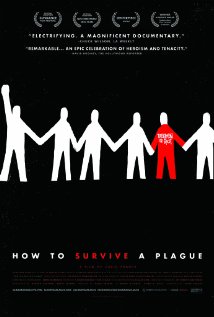Production
The documentary was produced using over 700 hours of archived footage, including news coverage, interviews, and footage of demonstrations, meetings, and conferences filmed by ACT UP members themselves. France notes that the activists were aware their actions were historic and that many of them would likely die. The film premiered in select theaters across the United States on September 21, 2012, and also includes footage of a 1989 demonstration during mass at St. Patrick's Cathedral in 1989. [6]
Release
The film had its world premiere at the Sundance Film Festival on January 22, 2012. [7]
It opened in a limited theatrical release in the United States on September 21, 2012. [8]
It was released on DVD and Blu-ray on February 26, 2013. [9] In November 2023, ROCO Films and GATHR launched a documentary speakers bureau partnership that included How to Survive a Plague, which made the film available for community-based screenings augmented by subject-matter experts. [10]
Summary
Beginning at the start of the HIV/AIDS epidemic in New York City, the documentary follows a group of AIDS activists and founders of the AIDS group ACT UP, and follows their struggle for response from the United States government and medical establishment in developing effective HIV/AIDS medications. Activists took it upon themselves to convince the FDA to approve drugs which could slow or even halt the HIV virus, and demanded that drug trials (which would usually take 7–10 years) be shortened so potentially life-saving treatments could be made available. The film also documents the underground market for HIV drugs: many people relied on drugs imported from other countries, which were believed to potentially slow down the HIV virus despite not being FDA-approved.
At the time, the only drug available to slow the progression of HIV was AZT, which in many cases was toxic to HIV-infected people. The cost of AZT was about $10,000 per year in the late 1980s. ACT UP's efforts led to the creation of the International AIDS Conference. Eventually, DDI, an alternative to AZT that did not cause blindness, was released by the FDA despite not going through a full-length safety trial.
HIV activists also protested the immigration policies banning HIV-positive people from immigrating to the United States as being discriminatory and homophobic.
When existing drugs proved ineffective as treatment for HIV, TAG lobbied for more research into the HIV virus. In 1996, protease inhibitors were released. These consist of a combination of drugs which lower the HIV viral load in patients more than any drug had before. It was considered a breakthrough in HIV and AIDS research and continues to be used as a treatment for HIV and AIDS.
The documentary included interviews with HIV activists, physicians and members of underground organizations as well as clips of the protests, meetings and news coverage taking place during the 1980s and 1990s.
France's book of the same title, expanding on the material, events, and people covered in the film, was published in 2016 to critical acclaim. It was described as "the definitive book on AIDS activism", [11] was long-listed for the Andrew Carnegie Medal for Excellence [12] and was named to numerous best-of and top-ten lists, including the New York Times 100 Notable Books for 2016. [13]
Reception
Critical response
Currently, the film has a rating of 98% on Rotten Tomatoes, and an average score of 8.40/10, based on 80 reviews. The website's critical consensus states, "Angry, powerful, and stirring, How to Survive a Plague is a brilliantly constructed documentary about the activists who pushed for action to combat the AIDS epidemic". [14] It also has a score of 86 out of 100 on Metacritic, based on 23 critics, indicating "universal acclaim". [15]
AIDS historian Sarah Schulman has criticized the film for its focus on wealthy, white activists over the "different kinds of people from every class and background" involved in ACT UP. [16]
This page is based on this
Wikipedia article Text is available under the
CC BY-SA 4.0 license; additional terms may apply.
Images, videos and audio are available under their respective licenses.
